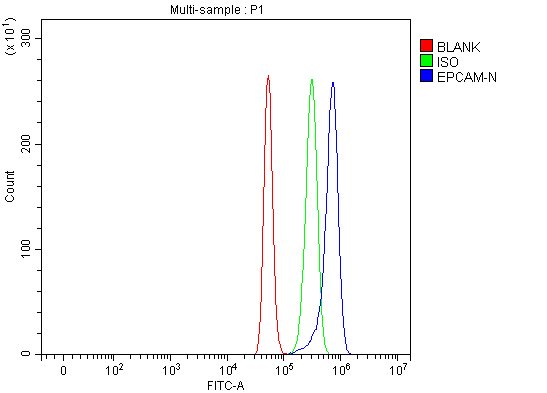Rabbit anti-Mouse, Rat CD326/Epcam Polyclonal Antibody | anti-CD326/Epcam antibody
Anti-CD326/Epcam Antibody Picoband
IHC(Paraffin-embedded Section), 1-2ug/ml, Mouse, Rat
IF: 5ug/ml, Mouse, Rat
FC/FACS (Fixed): 1-3ug /1x106 cells, Mouse
ELISA: 0.1-0.5ug/ml
FCM (Flow Cytometry)
(Figure 6. Flow Cytometry analysis of RAW264.7 cells using anti-CD326/Epcam antibody (AAA19728).Overlay histogram showing RAW264.7 cells stained with AAA19728 (Blue line). The cells were fixed with 4% paraformaldehyde and blocked with 10% normal goat serum. And then incubated with rabbit anti-CD326/Epcam Antibody (AAA19728, 1ug/1x106 cells) for 30 min at 20 degree C. DyLight488 conjugated goat anti-rabbit IgG was used as secondary antibody for 30 minutes at 20 degree C. Isotype control antibody (Green line) was rabbit IgG (1ug/1x106) used under the same conditions. Unlabelled sample (Red line) was also used as a control.)
IF (Immunofluorescence)
(Figure 5. IF analysis of CD326/Epcam using anti-CD326/Epcam antibody (AAA19728).CD326/Epcam was detected in a paraffin-embedded section of rat colon cancer tissue. Heat mediated antigen retrieval was performed in EDTA buffer (pH 8.0, epitope retrieval solution). The tissue section was blocked with 10% goat serum. The tissue section was then incubated with 5ug/mL rabbit anti-CD326/Epcam Antibody (AAA19728) overnight at 4 degree C. FITC Conjugated Goat Anti-Rabbit IgG (BA1105) was used as secondary antibody at 1:500 dilution and incubated for 30 minutes at 37 degree C. The section was counterstained with DAPI. Visualize using a fluorescence microscope and filter sets appropriate for the label used.)
IF (Immunofluorescence)
(Figure 4. IF analysis of CD326/Epcam using anti-CD326/Epcam antibody (AAA19728).CD326/Epcam was detected in a paraffin-embedded section of mouse colon cancer tissue. Heat mediated antigen retrieval was performed in EDTA buffer (pH 8.0, epitope retrieval solution). The tissue section was blocked with 10% goat serum. The tissue section was then incubated with 5ug/mL rabbit anti-CD326/Epcam Antibody (AAA19728) overnight at 4 degree C. FITC Conjugated Goat Anti-Rabbit IgG (BA1105) was used as secondary antibody at 1:500 dilution and incubated for 30 minutes at 37 degree C. The section was counterstained with DAPI. Visualize using a fluorescence microscope and filter sets appropriate for the label used.)
IHC (Immunohistochemistry)
(Figure 3. IHC analysis of CD326/Epcam using anti-CD326/Epcam antibody (AAA19728).CD326/Epcam was detected in a paraffin-embedded section of mouse colon tissue. Heat mediated antigen retrieval was performed in EDTA buffer (pH 8.0, epitope retrieval solution). The tissue section was blocked with 10% goat serum. The tissue section was then incubated with 2ug/ml rabbit anti-CD326/Epcam Antibody (AAA19728) overnight at 4 degree C. Peroxidase Conjugated Goat Anti-rabbit IgG was used as secondary antibody and incubated for 30 minutes at 37 degree C. The tissue section was developed using HRP Conjugated Rabbit IgG Super Vision Assay Kit ( epitope retrieval solution). The tissue section was blocked with 10% goat serum. The tissue section was then incubated with 2ug/ml rabbit anti-CD326/Epcam Antibody (AAA19728) overnight at 4 degree C. Peroxidase Conjugated Goat Anti-rabbit IgG was used as secondary antibody and incubated for 30 minutes at 37 degree C. The tissue section was developed using HRP Conjugated Rabbit IgG Super Vision Assay Kit (Lane 2: mouse kidney tissue lysates.After electrophoresis, proteins were transferred to a nitrocellulose membrane at 150 mA for 50-90 minutes. Blocked the membrane with 5% non-fat milk/TBS for 1.5 hour at RT. The membrane was incubated with rabbit anti-CD326/Epcam antigen affinity purified polyclonal antibody (#AAA19728) at 0.25ug/mL overnight at 4 degree C, then washed with TBS-0.1%Tween 3 times with 5 minutes each and probed with a goat anti-rabbit IgG-HRP secondary antibody at a dilution of 1:5000 for 1.5 hour at RT. The signal is developed using an Enhanced Chemiluminescent detection (ECL) kit (40 kDa.)






















